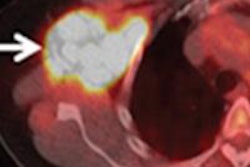Study presenter Dr. Robert Flavell, PhD, a clinical fellow in nuclear medicine, explained to AuntMinnie.com how pulmonary nodules can sometimes represent metastases, and how this "simple technique, which can be done without additional radiation or scanner time, may cause greater sensitivity for detecting metastatic disease."
Flavell and colleagues cited previous studies that showed how pulmonary nodules can be missed during the nonbreath-hold CT portion of FDG-PET/CT scans. To overcome this deficiency, the researchers evaluated whole-body PET/CT, high-resolution sharp lung reconstruction of PET/CT images, and diagnostic breath-hold chest CT.
The study cohort included 25 patients with a history of lung cancer who had received both a PET/CT scan for staging or restaging and a diagnostic chest CT within two weeks. All PET/CT exams included a high-resolution lung reformat with the sharp reconstruction filter and 2-mm slice thickness, compared with 3.75- to 5-mm thicknesses for conventional PET/CT.
On average, nearly four additional nodules per patient were found using the high-resolution lung reformat PET/CT technique and with breath-hold CT. In fact, a greater number of nodules, as well as more nodules smaller than 8 mm, were detected with high-resolution reformatted PET/CT and breath-hold CT than with whole-body PET/CT.
"Based on the results of this study, we found that this higher resolution technique causes increased sensitivity for the detection of pulmonary nodules," Flavell said.
There are "two major avenues for future investigation," he added. "The first is clinical follow-up for the outcome of missed nodules. Specifically, how often is a missed nodule a metastasis? Second, we plan on investigating the ability of these high-resolution reformats to improve staging of other cancers."



















